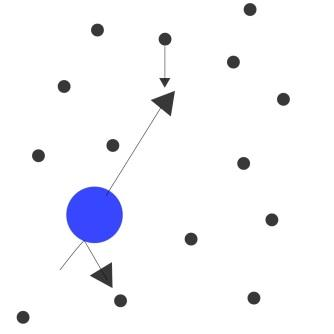
What is the cause of Brownian movement in colloids?
Answer
496.2k+ views
Hint: Let’s start with discussing the Brownian movement; Brownian movement can be defined as the random movement of the particles at microscopic level. This type of motion generally depicts the random fluctuation in position inside the fluid subdomain. The motion is zigzag and unpredictable in nature.
Complete step by step answer:

Diagram showing the brownian movement of particle
We must know the Brownian motion/movement is observed due to collision between the particles inside the fluid subdomain. The Brownian motion rate is dependent on the temperature, number of particles, size of particles and viscosity of the medium. The rate of Brownian motion will increase as we increase the temperature, increase the number of particles (as it increases the frequency of collision), smaller the size of particles and the lower the viscosity of the dispersing medium.
Coming to the question, the cause of Brownian movement in colloids is due to the unbalanced4 bombardment or we can say collision between the particles or the particles and the walls of the container or the particles of colloids and the particles of dispersion medium.
It is to be noted that this Brownian motion helps in stabilising the colloidal solution as this Brownian motion doesn’t allow the particles of the sol. to settle down and hence the colloidal solution remains stable.
Note:
We can observe Brownian motion by seeing dust particles through a tiny ray of light in a dark room. You will observe that the dust particles are randomly moving and are not settling down. Also if you focus on a single particle then after sometime that particle will disappear. This shows the unpredictable motion of the particles.
Complete step by step answer:

Diagram showing the brownian movement of particle
We must know the Brownian motion/movement is observed due to collision between the particles inside the fluid subdomain. The Brownian motion rate is dependent on the temperature, number of particles, size of particles and viscosity of the medium. The rate of Brownian motion will increase as we increase the temperature, increase the number of particles (as it increases the frequency of collision), smaller the size of particles and the lower the viscosity of the dispersing medium.
Coming to the question, the cause of Brownian movement in colloids is due to the unbalanced4 bombardment or we can say collision between the particles or the particles and the walls of the container or the particles of colloids and the particles of dispersion medium.
It is to be noted that this Brownian motion helps in stabilising the colloidal solution as this Brownian motion doesn’t allow the particles of the sol. to settle down and hence the colloidal solution remains stable.
Note:
We can observe Brownian motion by seeing dust particles through a tiny ray of light in a dark room. You will observe that the dust particles are randomly moving and are not settling down. Also if you focus on a single particle then after sometime that particle will disappear. This shows the unpredictable motion of the particles.
Latest Vedantu courses for you
Grade 11 Science PCM | CBSE | SCHOOL | English
CBSE (2025-26)
School Full course for CBSE students
₹41,848 per year
Recently Updated Pages
Master Class 9 General Knowledge: Engaging Questions & Answers for Success

Master Class 9 English: Engaging Questions & Answers for Success

Master Class 9 Science: Engaging Questions & Answers for Success

Master Class 9 Social Science: Engaging Questions & Answers for Success

Master Class 9 Maths: Engaging Questions & Answers for Success

Class 9 Question and Answer - Your Ultimate Solutions Guide

Trending doubts
State and prove Bernoullis theorem class 11 physics CBSE

What are Quantum numbers Explain the quantum number class 11 chemistry CBSE

Who built the Grand Trunk Road AChandragupta Maurya class 11 social science CBSE

1 ton equals to A 100 kg B 1000 kg C 10 kg D 10000 class 11 physics CBSE

State the laws of reflection of light

One Metric ton is equal to kg A 10000 B 1000 C 100 class 11 physics CBSE




